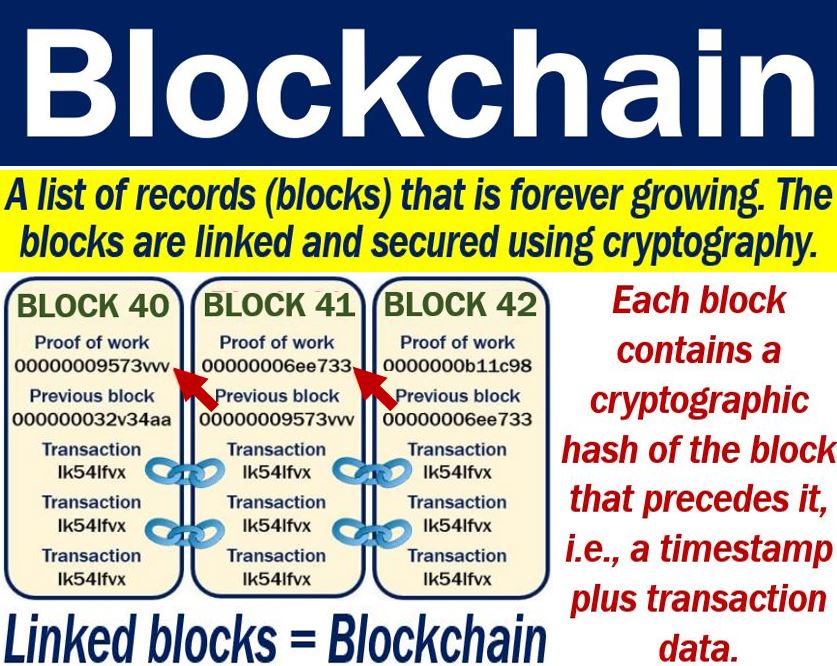A blockchain is a list of records that is forever growing. We call those records blocks. The blocks are linked and secured using cryptography. Cryptography is the art of creating and deciphering code. In the world of cryptocurrencies, a blockchain provides the validity of each cryptocurrency’s chain.
Each block has a hash pointer which serves as a link to the block that came before it. The hash pointer has a timestamp as well as transaction data.
The creators of cryptocurrencies designed blockchains to be resistant to modification. Specifically, resistant to data modification.
A block is like a ledger page while a blockchain is the whole ledger book.
Each block has data on the block preceding it. However, the Genesis Block has no such data because there is no block before it. The Genesis Block is the first one in the chain.
Blockchain or block chain?
There are two possible spellings for the term: ‘blockchain’ or ‘block chain.’ Initially, the two-word form was more common. Now, however, it is the other way round, i.e., the single-word form is more common.

Blockchain miners
We call the people who check that transaction information is correct ‘miners.’ Miners also add data to each block.
When miners have completed each process, they receive a reward. Their reward consists of cryptocurrency units.
We call this procedure of validation, adding data and then receiving rewards, ‘cryptocurrency mining.‘
While early blockchain networks, such as Bitcoin, relied on energy-intensive Proof-of-Work (PoW), many modern networks have transitioned to alternative methods like Proof-of-Stake (PoS). These newer consensus mechanisms not only reduce energy consumption but also maintain robust security. In addition, emerging models such as Delegated Proof-of-Stake (DPoS) and Practical Byzantine Fault Tolerance (PBFT) are expanding the options available for decentralized validation.
Blockchain – distributed ledger
A distributed ledger is a ledger of all transactions supported by a decentralized network from across several locations and people. We also call it a shared ledger.
It is not a centralized ledger. Instead, the same data appears and remains in many different places. With a distributed ledger, there is no central authority.
A blockchain is a distributed ledger database. It stores each transaction in a separate block. The blocks link to each other in chronological order.
Smart contracts
Blockchains store what we call smart contracts. A smart contract consists of lines of code that allow the contract to be self-executing. There is not need for lawyers or other intermediaries.
Block explorers
If you want to know what is happening and has happened throughout a blockchain, you need a block explorer. It is an online tool that allows you to search through the whole network.
With this tool, you can monitor balances, check confirmations, track transfers, and examine network statistics.
Each explorer only works for a specific coin. A Litecoin explorer, for example, won’t work on a Bitcoin blockchain.
Brief blockchain history
1991 – Stornetta and Haber
W. Scott Stornetta and Stuart Haber were the first people to describe work using cryptography to secure a chain of blocks.
They incorporated hash trees into their design. This made it possible to collect many documents in one block, thus making it considerably more efficient.
The term ‘hash tree’ or ‘Merkel tree’ has a specific meaning in computer science and cryptography. It is a tree in which each leaf node has a label containing the hash of a data block. Also, each non-leaf node has a label with the cryptographic hash of the labels of its preceding nodes.
In this context, a node is a computer that connect to the network.
2002 – Shasha and Mazières
Dennis Shasha and David Mazières proposed a network system of files with decentralized trust. In this system, writers to the file system trusted one another. However, the trust did not extend to the network in between.
Shasha and Mazières’ system achieved file system integrity by writing signed commits to a shared, append-only signature chain. The chain captured the file system root (which in turn was a hash tree).
This was a proto-blockchain in which all clients with authorization could write. In modern blockchains, however, clients (miners) need to solve a cryptographic puzzle before they can write one block.
2005 – Szabo
Nick Szabo proposed a system with many blockchain properties. He designed it for decentralized property titles and also his bit gold system. The system utilized chained proof-of-work and timestamping.
However, his method of double-spending protection had a major weakness. It was vulnerable to Sybil attacks.
2008 – Satoshi Nakamoto
Satoshi Nakamoto, conceptualized the first modern blockchain. Namoto designed Bitcoin, the first cryptocurrency, which came onto the market in 2009.
The bitcoin file size reached 20GB (gigabytes) in August 2014. By January 2015, it had reached nearly 30GB and exceeded 100GB in size by January 2017.
In Namoto’s original papers, he wrote the term as two words, i.e., block chain. This style eventually gave way to the single-word spelling.
Modern Blockchain Use Cases
In recent years, blockchain technology has expanded well beyond its original application in cryptocurrencies. For example, decentralized finance (DeFi) platforms now enable users to access lending, borrowing, and trading services without traditional intermediaries.
In addition, non-fungible tokens (NFTs) have provided new avenues of digital ownership by allowing unique digital assets to be securely bought, sold, and traded.
Other sectors, such as supply chain management, healthcare, and identity verification, are also leveraging blockchain’s transparency and security features to streamline operations and improve trust.
Scalability and Environmental Impact
As blockchain networks grow in size and usage, scalability has become a key challenge. Innovative solutions like Layer-2 scaling techniques, sharding, and off-chain transactions are being developed to address issues related to transaction speed and network capacity.
Environmental concerns about energy consumption, especially from mining operations, have prompted a move toward more sustainable practices and alternative consensus algorithms, helping to reduce the overall carbon footprint of blockchain technology.
